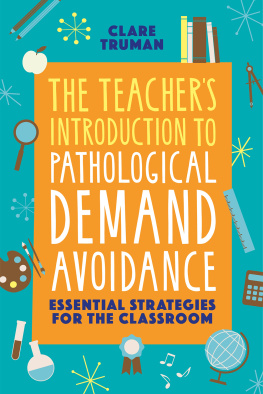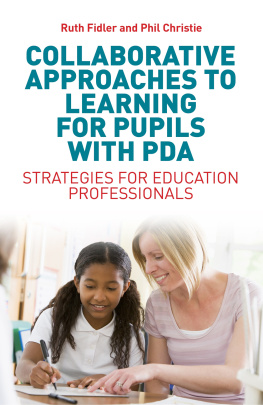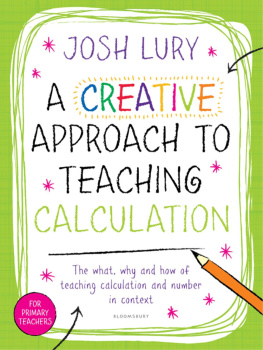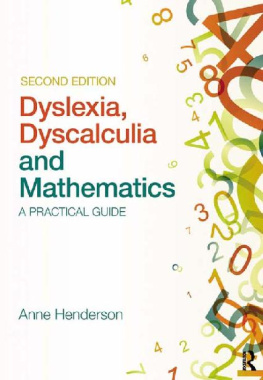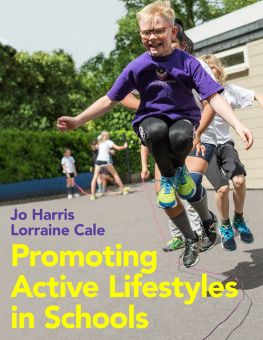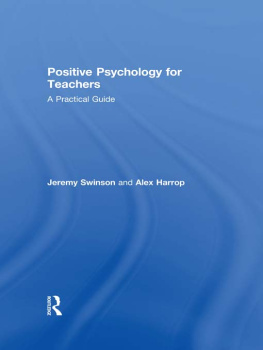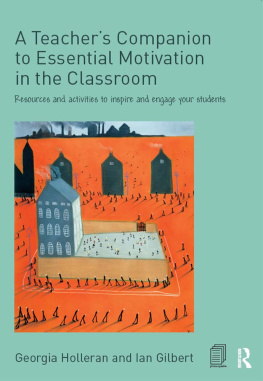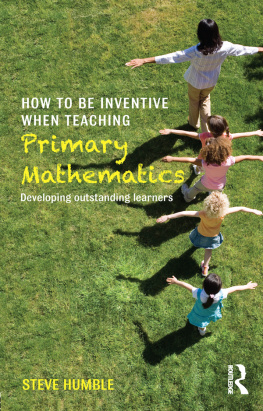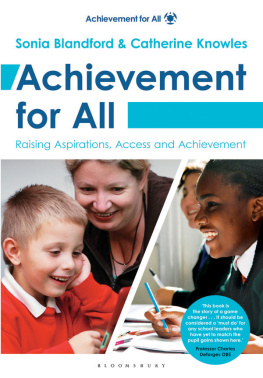Contents

THE TEACHERS
INTRODUCTION TO
PATHOLOGICAL
DEMAND
AVOIDANCE
ESSENTIAL STRATEGIES
FOR THE CLASSROOM
CLARE TRUMAN

Contents
Preface
I often say that I come to autism wearing three hats. I am, first and foremost, big sister to an autistic young man. His story is his to tell so I wont talk about him much here, suffice to say that he is the reason that I became interested in this field. My second hat is that of the special needs teacher. I have been teaching for thirteen years and specializing in autism for ten; teaching in special needs schools and alternative provisions for those for whom school is not the right learning environment. Finally, I am a student, studying for a PhD at UCL in London, exploring the educational experiences of school-aged autistic children and young people with a PDA profile.
These three roles can complement each other and challenge each other. From a research perspective, the jury is still out on the exact nature of PDA, its relationship to autism, its usefulness and validity as a diagnosis and the impact of the profile on peoples educational experience. Yet, in the classroom, I have worked with students whose autism diagnosis only seems to tell half of the story and who need the adults around them to take a very different approach to teaching and supporting them. It will be a long time yet before the debates around the nature of PDA are settled, if they ever are. However, whatever we call it, we owe it to those children to learn as much as we can about what they need and how to deliver it.
My first experience of working with students with PDA was as a teacher in a specialist school for autistic children and young people. Having an autistic brother and having already taught in other specialist schools, I thought I had sufficient knowledge of the strategies I would need to meet the needs of the pupils I would teach at that school, but the students with PDA turned my approach to teaching on its head. I felt like my toolbox was empty. I had to unlearn what I already knew and then begin to learn again, through reading, attending training courses, chatting with other teachers and a great deal of trial and error, how to work with these students who needed a very different approach to meet their needs. It is this professional experience that forms the bulk of this book.
Later, I established a social enterprise called Spectrum Space which provided education for a small number of autistic students in Surrey who were not able to access school. Most of the Spectrum Space students had a PDA profile and the provision was designed from the outset with PDA students in mind. The curriculum, environment and teaching style was tailored specifically to meet the needs of people with PDA. We provided education both in the home and in a community building, with two adults supporting every child to maximize the amount of flexibility the students had to follow their own agenda and learn in their own style. More about Spectrum Space and how it worked can be found in as well as in examples that run through the book. While the set-up was unusual and may be very different from the setting you are working in, having the freedom to design a bespoke provision gave me the opportunity to really think about how learning is best delivered for children and young people with this profile and to develop many of the strategies and approaches that I explore in this book.
Both in schools and at Spectrum Space I found that I was drawn to teaching and supporting the children with PDA. These students taught me a whole new way of working with children and young people, and I am very grateful to those students and their families (whose names have all been changed in this book) who have allowed me to tell you more about them and what they taught me.
Now, I offer training and consultancy to schools, colleges, teachers, learning support staff and other professionals in how to support children and young people with PDA, as well as supporting some children and young people whose education is provided in the home. More and more professionals are realizing that there is a group of autistic children and young people whose needs are not being met by what is considered to be best practice for supporting autistic students and who are looking for a different approach so that they can be supported to enjoy and achieve in their education and beyond. Of course, every student is an individual, and what works for one student with PDA may not work for another, but this book will summarize different ways of working in the classroom that will support many students with PDA.
It is important to acknowledge that I dont have PDA myself and I encourage you to seek out the voices of those who do. There are many adults and some children with PDA who are writing books and blogs and producing images and video content to explain the experience of PDA from an insider perspective. Listening to the voices of people with PDA is important and often overlooked. If we spend all our time in the professional bubble, we can miss the lessons of this lived experience. This book will give you the teachers experience of PDA in the classroom, but I encourage you to explore more widely as well and read this alongside soaking up some of the first-person accounts of PDA. The Life with PDA section of the PDA Society website (www.pdasociety.org.uk) is a great place to start.
Finally, we will be talking about PDA and demand avoidance, PDA and anxiety, PDA and control, but over time I have come to realize that, at its root, PDA is about freedom. Harry Thompson, an adult with PDA, describes the condition as an instinctual desire to be free (Thompson 2019, p.24). If we are honest, a lot of teacherstudent interactions curtail students freedom. While this book will give you many strategies to support children and young people with PDA to access learning and other opportunities, it is important to remember how important freedom is to these students and try to rein in our instinctual desire as teachers to lead the interactions. These children and young people will show us what we need to do to support them if we let them be the teachers.
Chapter 1
PDA WHAT DO WE
KNOW SO FAR?
Pathological Demand Avoidance is a term that was first coined by a developmental psychologist named Elizabeth Newson when she was working in Nottingham in the 1980s. She was working at a specialist clinic conducting diagnostic assessments of children. Over the course of six years, Newson met 21 children who had been referred for assessment as their presentation reminded the referrers of autism but their traits did not seem to quite fit this diagnosis. Newson and her colleagues noticed that these children, while not typical of the autistic children they assessed, were similar to each other in many ways, and so, along with her team, she began to identify the features that these children had in common. By 2003, the number of cases seen at the clinic had risen to 150, and Newson along with two colleagues published the first peer-reviewed journal article on the topic (Newson, Le Marchal and David 2003). The description they gave in that article is the foundation of the understanding of PDA that we have today.
Pathological Demand Avoidance, as the name suggests, is characterized by an avoidance of the ordinary, everyday demands of life. We are all familiar with children who avoid doing their homework, brushing their teeth or eating broccoli, but individuals with PDA avoid demands to such an extent that it interferes with their daily life, that is why it is described as pathological. The demand avoidance extends from routine demands, such as washing, eating, drinking and dressing, to things the individual is capable of accomplishing and may have done on several occasions before, even to things they want to do, such as favourite play or leisure activities. It is thought that this demand avoidance is rooted in anxiety, and so PDA is sometimes described as an anxiety-driven need to be in control.

